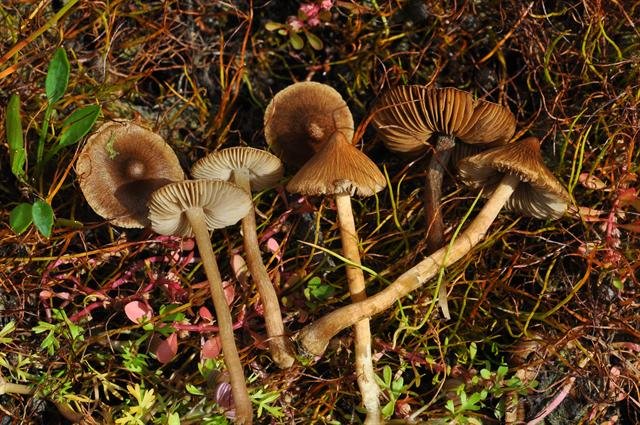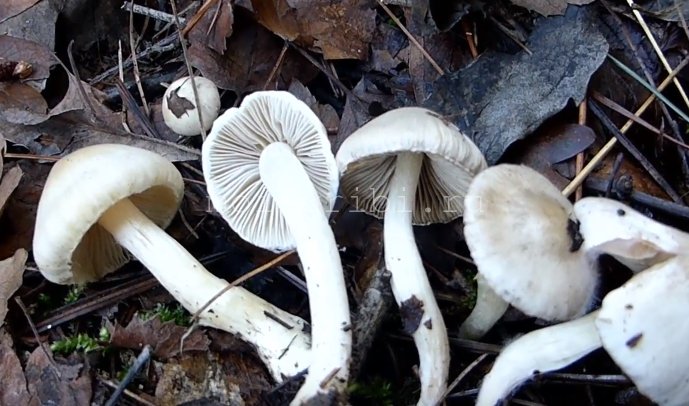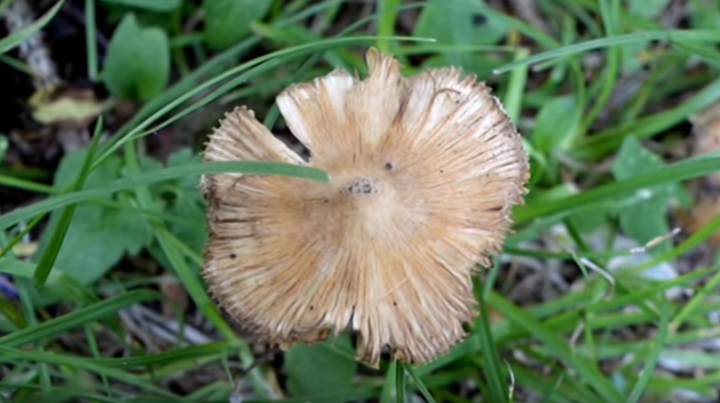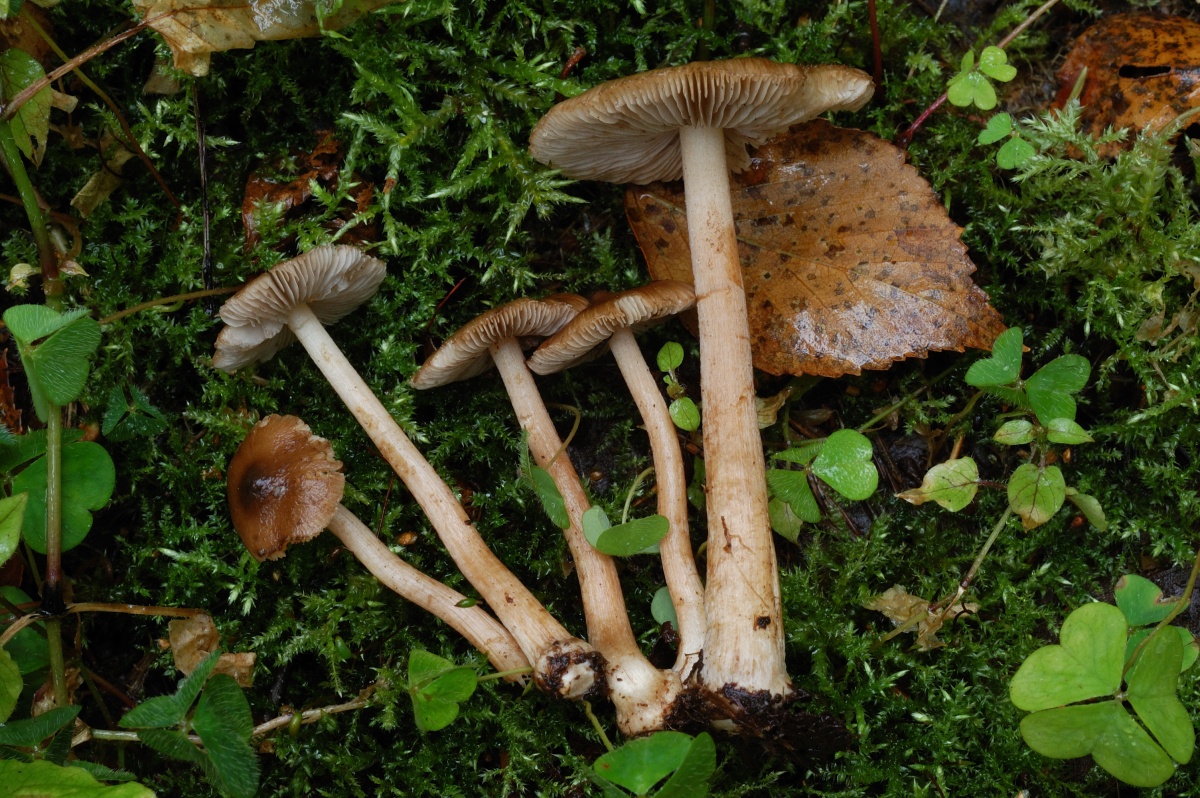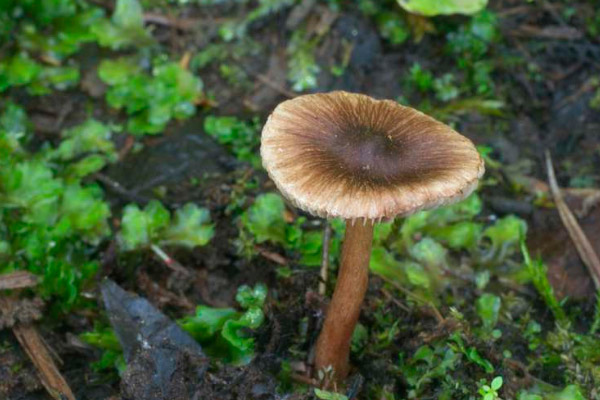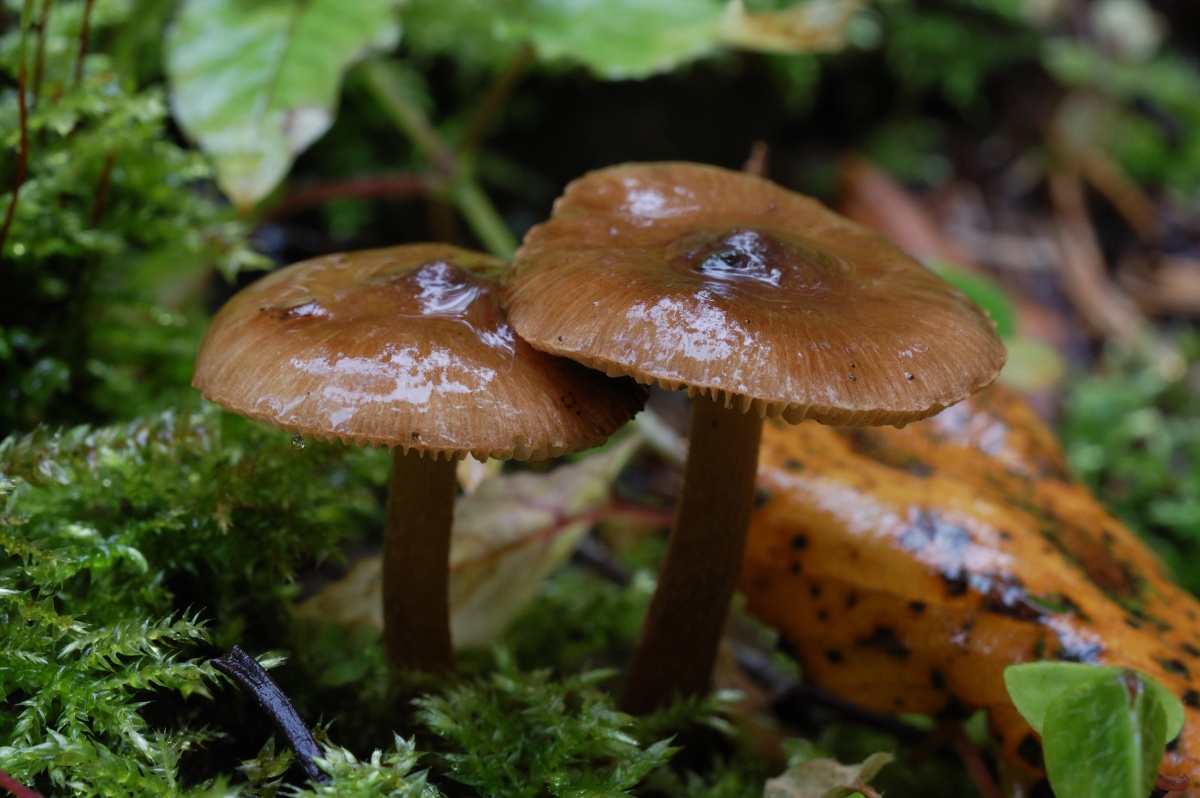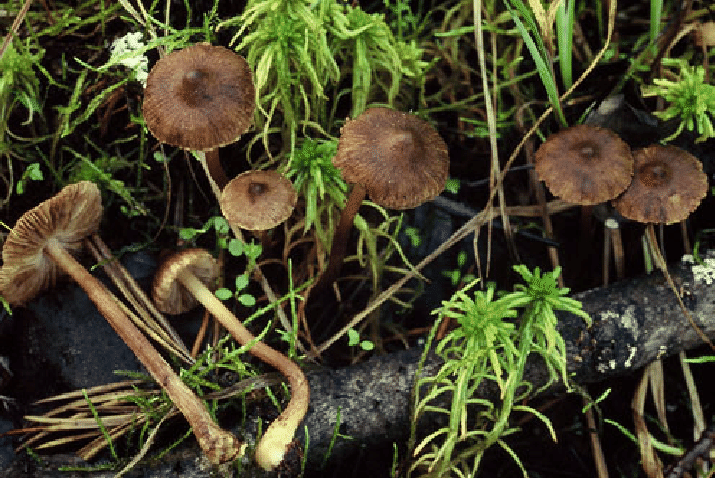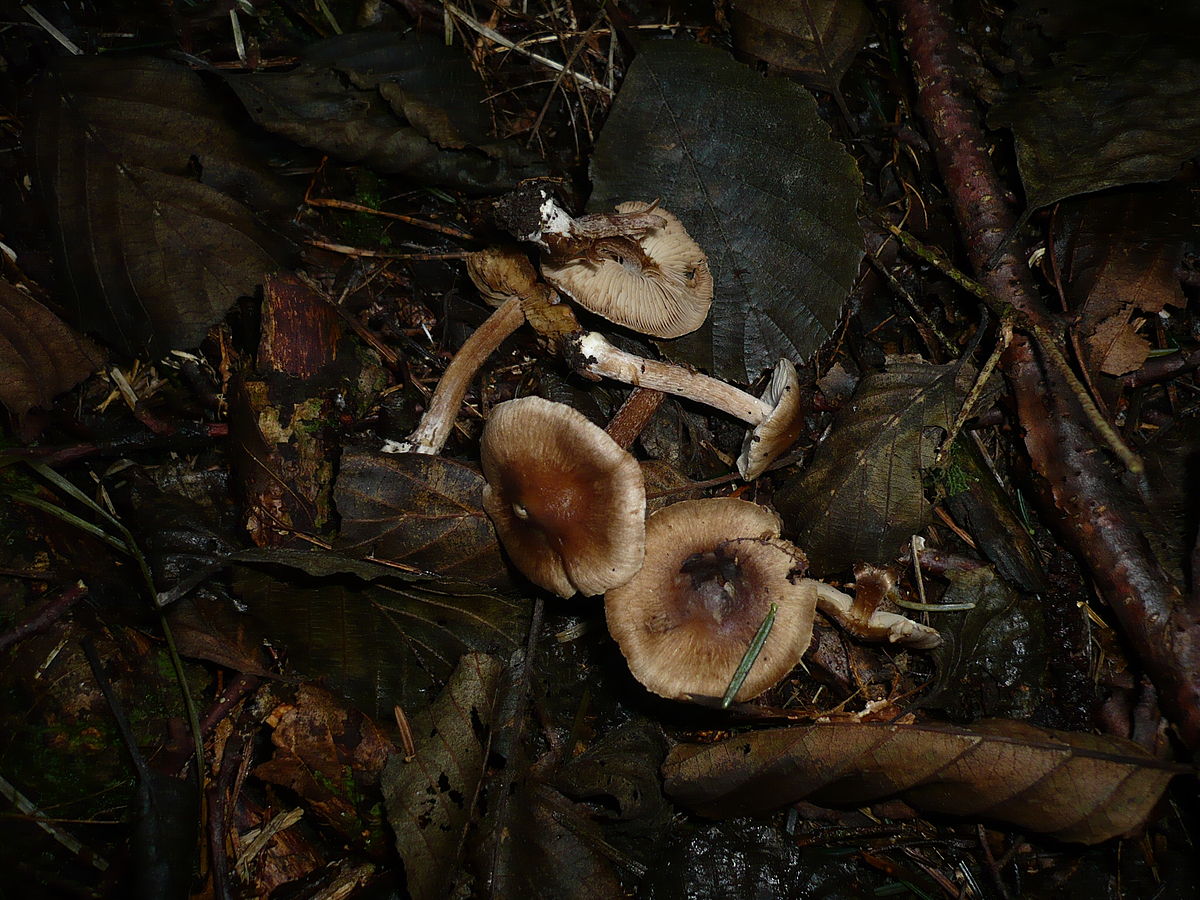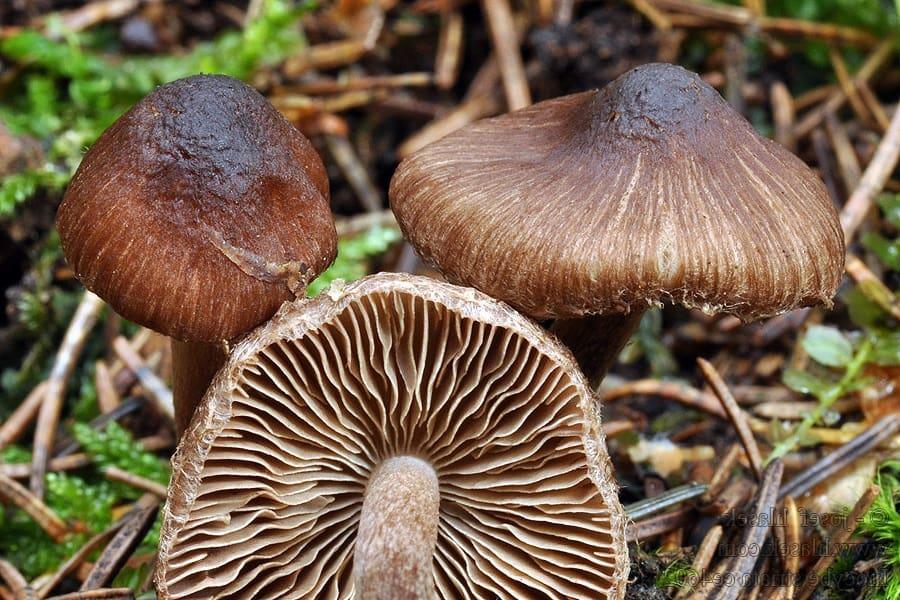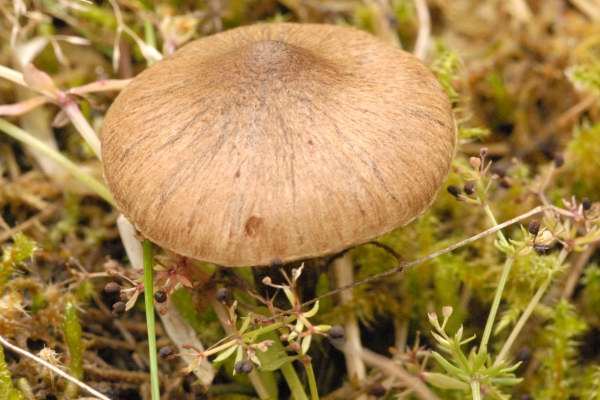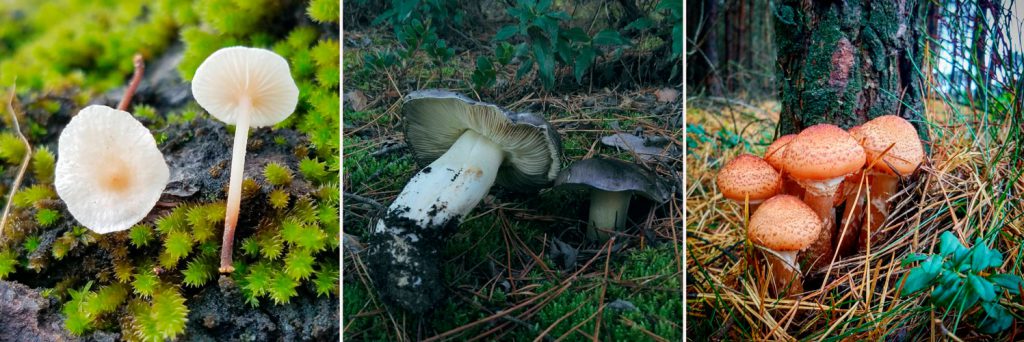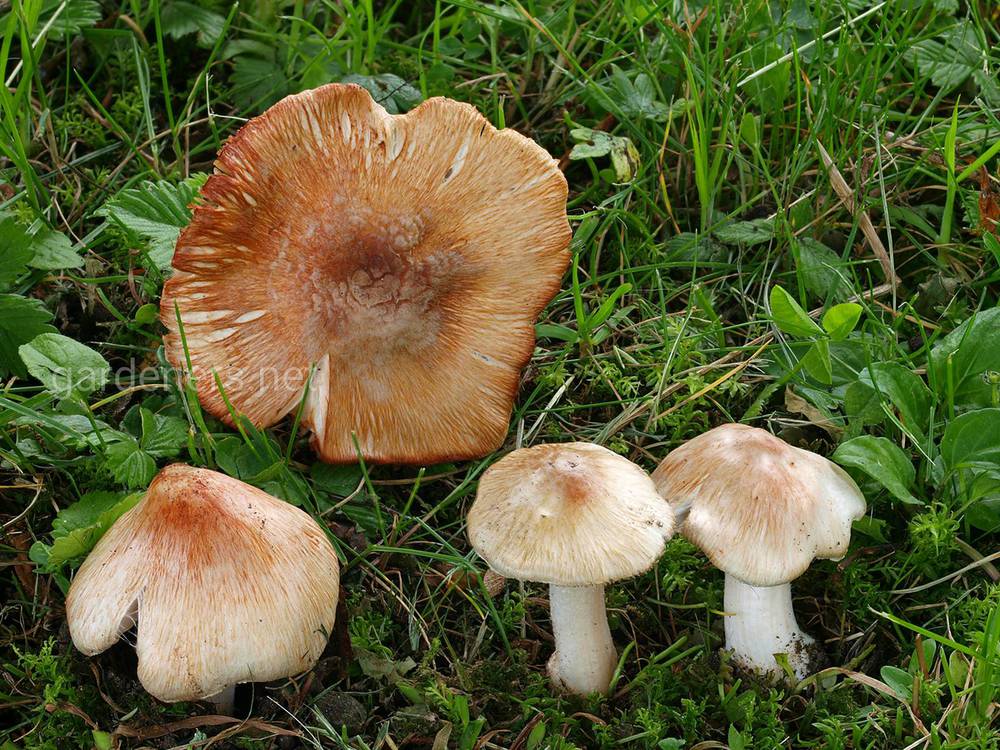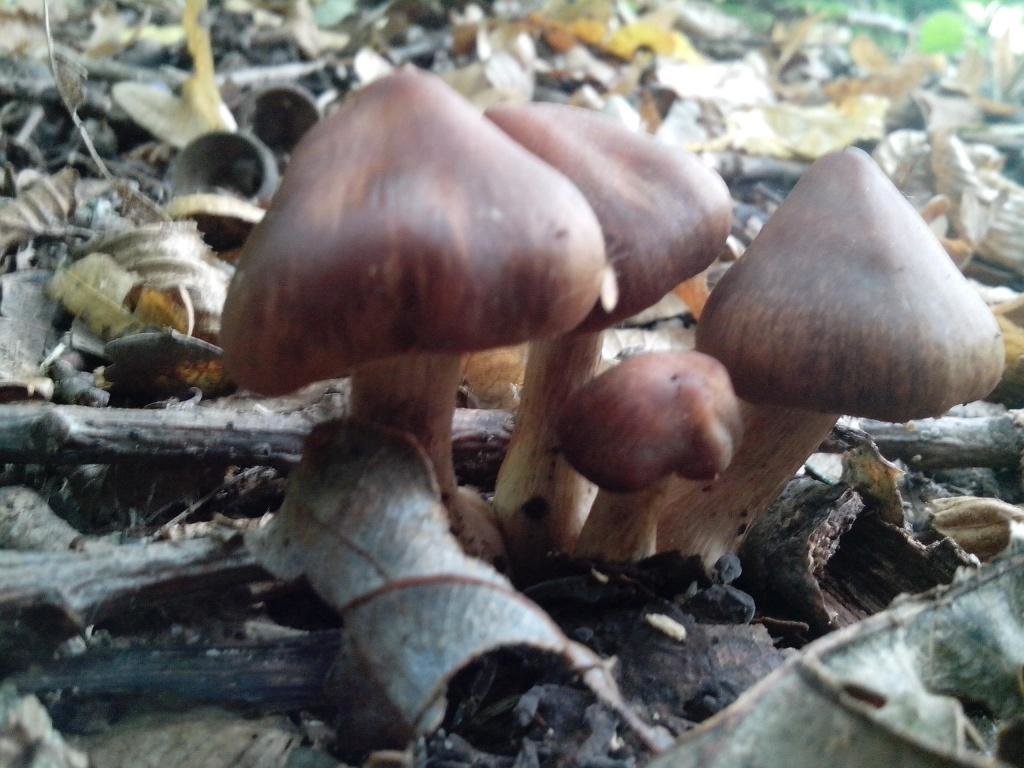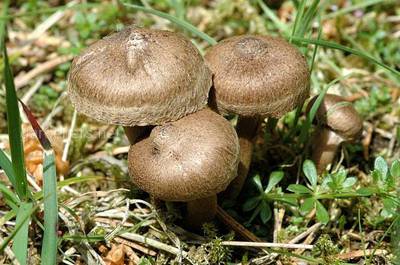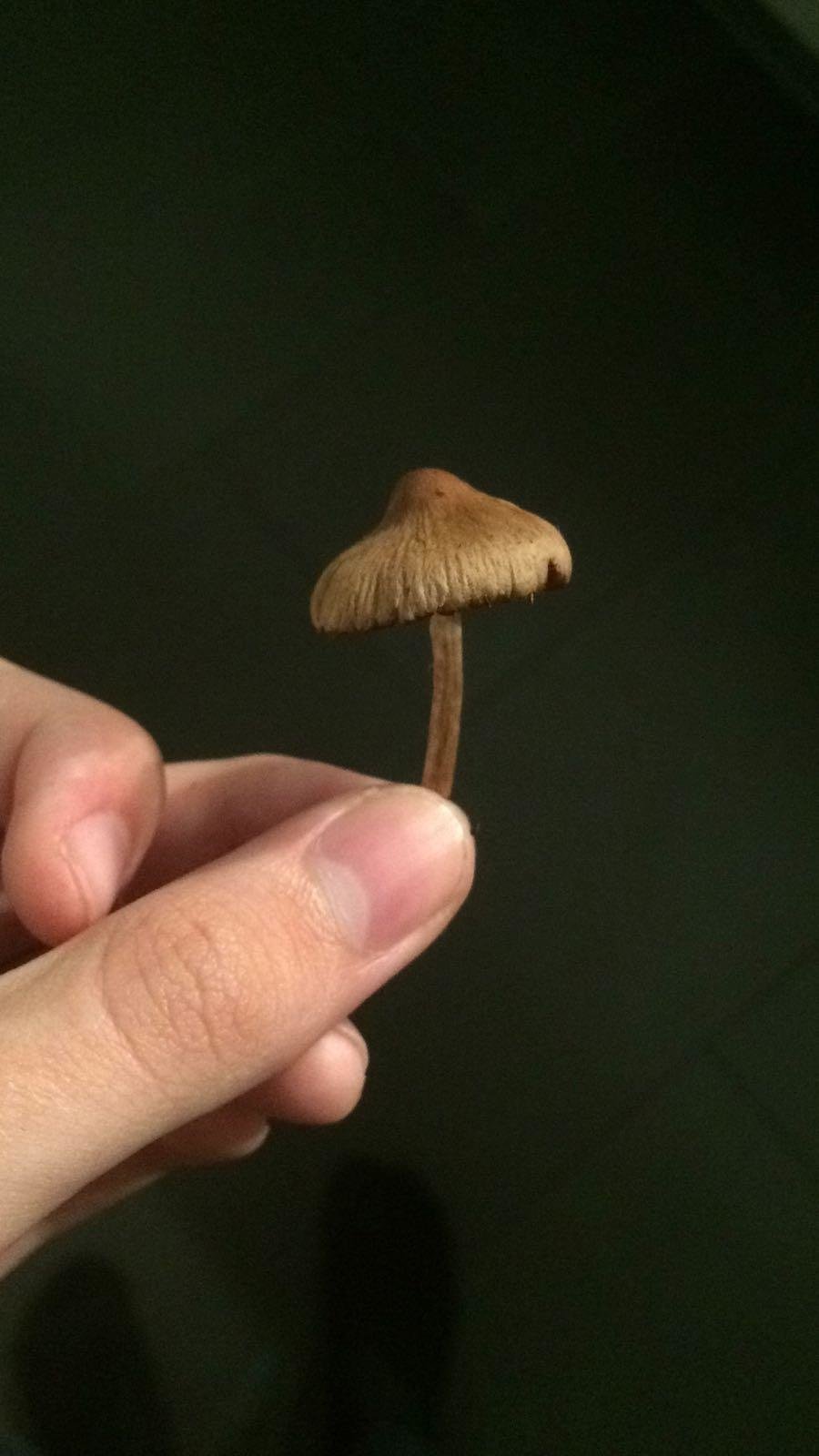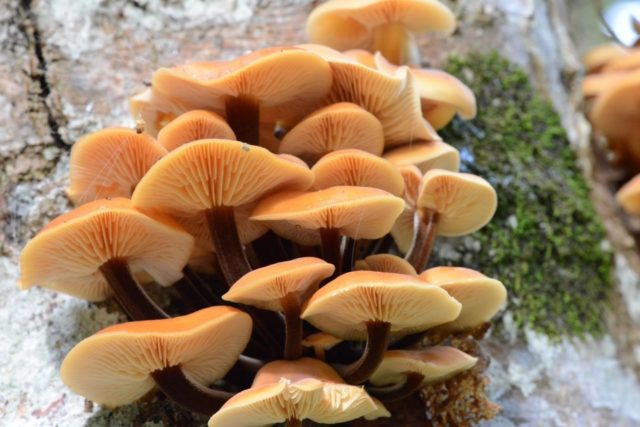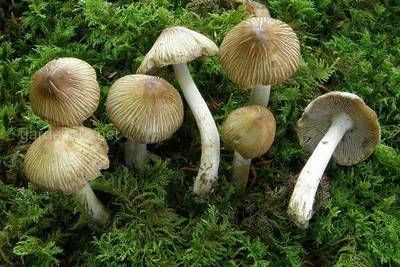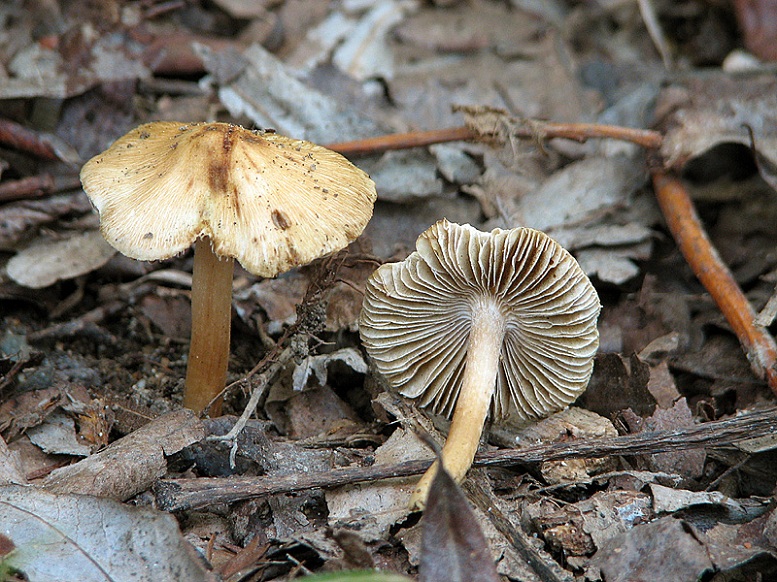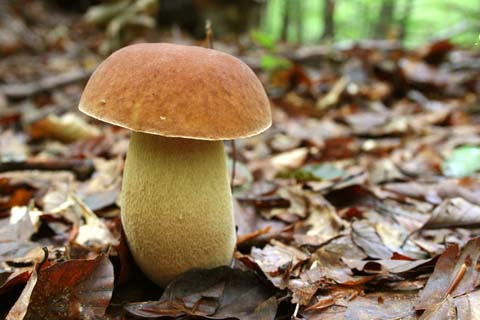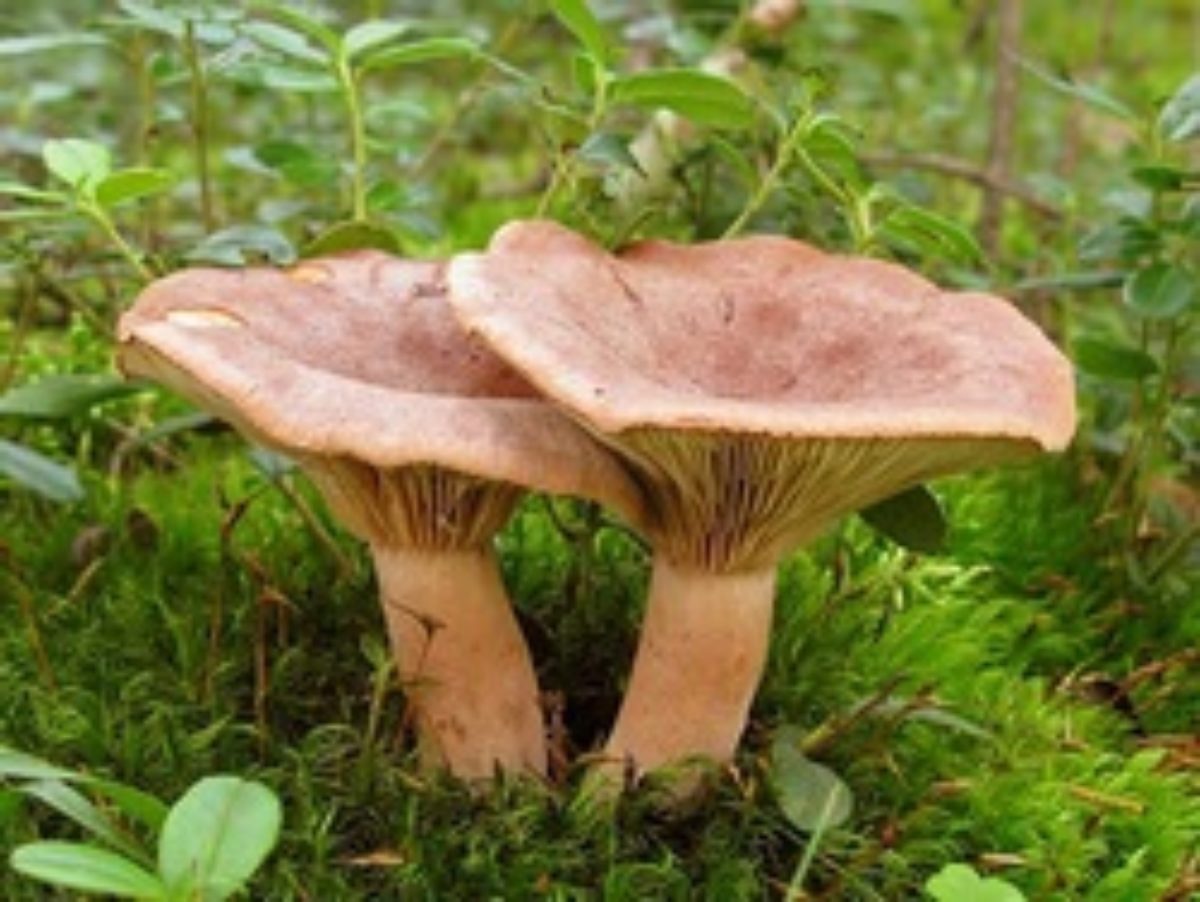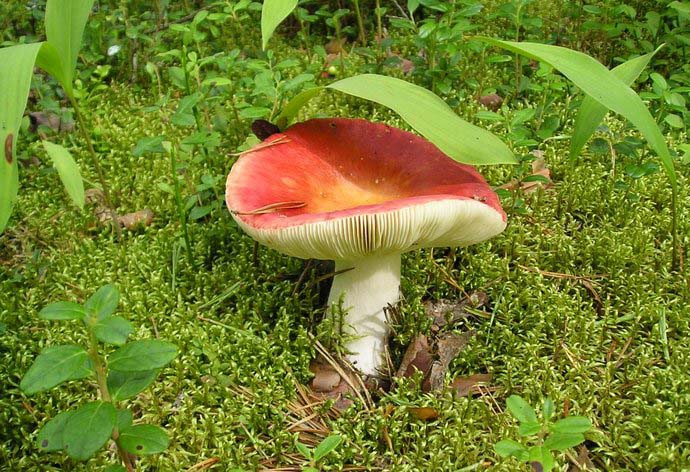False doubles
The danger of inocyba lies in its similarity with other species that do not contain toxins. It is useful for the mushroom picker to study the photo of the Patouillard fiber and similar specimens in order to better understand what the differences are.
Edible mushrooms with which this species can be confused:
- Ryadovka May or May mushroom - the main differences are the absence of red in the color of the cap and a pronounced flour smell;
- russula - not very similar to a poisonous species, but novice mushroom pickers can still make a mistake. The russula, unlike the fiber, has the usual mushroom smell, the flesh does not turn red in the places of pressure and there is no tubercle in the center of the cap;
- Royal champignon is a delicious edible mushroom that is somewhat similar to the poisonous inocyba. However, its color does not have a red tint, the fruit does not turn red when pressed, and the plates on the inside of the cap are beige.
The toxic counterpart is the less poisonous mushroom Fibers Gode, which differs only in its smaller size and a leg that is swollen at the bottom. Red tints are also present in the coloration.
The photographs show exactly how the Patuillard fiber differs with similar appearance. Even a beginner will be able to determine the characteristics of mushrooms.
Poisoning and first aid
- In the fruiting bodies (mushrooms) there is a high concentration of the substance muscarin, which belongs to toxins. Its content in Fiber patuillard is 25 times higher than in classic red fly agarics.
- The action of the poison affects the functioning of the autonomic nervous system. When ingested in high doses, muscarine causes death due to the arrest of the heart muscle and the cessation of respiratory function. On average, depending on the weight of a person, a lethal dose will be from 10 to 80 g of fresh fiber pulp.
- The first signs of poisoning appear in the period from 30 minutes to 2 hours after the product is consumed. The victim develops lacrimation, there is a sharp drop in pressure and pulse. Further breathing is disturbed, profuse diarrhea and vomiting begin. The patient's condition deteriorates sharply as the symptoms increase. If you suspect poisoning, you need to urgently call an ambulance, and before that, provide first aid.
- Before the arrival of the doctors, if possible, they wash the victim's stomach. He also needs to drink crushed activated carbon, dissolved in water, or another fast-acting sorbent, which, even in small doses, is not absorbed by the body. Inducing vomiting is necessary only if it is known that a poisonous mushroom has been eaten, but the symptoms of poisoning have not yet appeared. Without medical assistance, the risk of death of the victim is very high.
- Poisonous mushrooms are often similar to edible ones. A careful study of its features will allow you to avoid poisoning with the Fiber Catouillard. A novice mushroom picker should not put dubious specimens in the basket, but rather go on a quiet hunt accompanied by a knowledgeable companion.
Fiber patuillard
Fiber patuillard - Latin Inocybe patouillardii
In another way, it is called Brick Fiber or Blushing Fiber.
Description
Mushroom cap
The diameter of the Brick Fiber hats ranges from 30 to 90 mm. Young specimens have “headdresses” in the form of cones or bells, the hats of adult mushrooms spread out and retain barely noticeable mounds in the middle.
They become covered with a smooth, fibrous skin that cracks as the fungus ages. At first, it has a white color, later it turns yellow, reddens and turns red.
The caps fill with a whitish flesh that turns red as it ripens, as well as when pressed and broken, especially in adult fungi.
Hat bottoms are filled with many frequent even or tearing plates, adhering to the stem or free. At first they have a white color, later they become sulfur-yellow, brownish-olive, pinkish and brown, with red spots. If you press on the plate bottom, it turns red.
Patouillard fibers reproduce by oval tobacco-brown spores that form in ocher-brown spore powder.
Stipe
The height of the reddening Fiber leg is no more than 70 mm, the thickness is 5-10 mm. Tight, cylindrical legs, filled with flesh, have a slight expansion at the bottom and are colored like caps, but slightly lighter. They are covered with a white coating. Over time, the legs can be partially or completely colored in reddish or reddish shades.
Fiber patuillard - Latin Inocybe patouillardii
Growing places
These fibers prefer loam and limestone-rich soil. They are found in conifers and deciduous forests with beech and linden trees, as well as in garden and park areas. The mushroom is widespread in the European part of Russia.
Fruiting of the fibula is family or two or three mushrooms, and occurs in May - October. It bears fruit especially abundantly in August - September.
Edibility
The pulp of Fiber brick does not smell and at the beginning of life has an unpleasant aftertaste. In the future, she begins to exude a sharp alcoholic aroma.
The fungus is poisonous: only 10 g of fruit bodies can be fatal, since they contain an extremely high amount of muscarin - several tens of times more than in fly agaric.
20 minutes after eating such mushrooms, the autonomic nervous system is affected, the person begins to vomit and vomit, diarrhea is observed, arms and legs tremble, dizzy, the heart works intermittently. Large doses lead to cardiac arrest or complete respiratory depression.
Description of the green fiber
The diameter of the green fiber cap is 2.5-9 centimeters. At first, the shape of the cap is rounded-bell-shaped, while its edges are wrapped inward, after which it becomes convex-outstretched with a central tubercle of an acute or obtuse shape.
The surface of the cap is felt-fibrous, scaly, cracking. The color of the cap is gray-green, olive green or dark brown, and the edges are nutty brown, usually with darker scales.
The color of the plates is at first gray-cream or whitish, but over time they become reddish-brown, sometimes their edges are white. When damaged, the plates turn slightly red. In the tubercle of the cap, the flesh is whitish, and at the base it is bluish-green. When cut, the flesh may turn pink. The pulp has a pleasant fruity aroma.
The leg is 2.5-10 centimeters long and 0.5-1 centimeters wide. The leg is cylindrical or thickened towards the base. The leg is fibrous, at first it is whitish, then in the lower part it becomes grayish-buffy with greenish spots, and in the upper part of the leg there is a flocculent hairy bloom.
Spores are ellipsoidal, unequal, light brown in color. Spore powder of brown or yellowish-brown color.
Places of growth of green fiber
These mushrooms form mycorrhiza with beech, oak and spruce. They grow in deciduous, mixed and coniferous forests. In our country, they are distributed throughout the temperate forest zone, giving preference to the south. They are often found along the edges of the roads.
Fruiting occurs in July-October. They grow on the ground singly or in groups.
Toxicity

The mushroom is deadly poisonous
and can cause severe, fatal muscarinic poisoning. Muscarine in Patuillard fiber contains 20-25 times more than in red fly agaric. Symptoms of poisoning appear in 0.5-2 hours and are expressed in severe lacrimation and sweating, followed by tachycardia, a sharp drop in blood pressure, respiratory failure, vomiting and diarrhea.The victim has a narrowing of the pupils, visual impairment, the skin turns red, then turns pale, all this is accompanied by severe chills. In especially severe cases, the use of atropine with the simultaneous supply of salted water and glucose is recommended. In any case, you need to seek medical help.
Sharp fiber: what it looks like, where it grows, edibility, how to distinguish it, photo
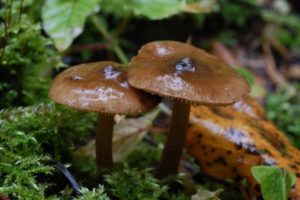
Sharp fiber belongs to the Fiber family, genus Fiber. This mushroom is often confused with a row of sulfur or honey agarics, it is also called a ragged or torn fiber. Eating this specimen for food in a random way can cause a lot of trouble for a person, since it is a toxic hallucinogenic mushroom.
What does acute fiber look like?
Considering the variety has the following characteristics:
- The cap of a young specimen is bell-shaped; over time, it becomes flat-convex with a sharp tubercle in the center. Its size varies from 2 to 8 cm in diameter. As a rule, the edges are torn, in fact, that is why it received the corresponding second name. With age, it completely cracks. The surface is silky-fibrous brown with a darkened tubercle in the middle.
- Frequent, wide and free from the leg plates are located under the cap. At a young age, they are light gray or yellowish, then gradually acquire a more saturated dark brown hue.
- The pulp of the fiber is of a sharp pale yellow or white color; when cut, its color does not change. It has an unpleasant taste and aroma.
- The leg is cylindrical in shape with a slightly widened base, the length of which is 2-4 cm, and the thickness is 0.2-0.4 cm. The upper part is light with a powdery bloom, and below it acquires a reddish-brown tint. It is slightly widened at the base.
- Spores are smooth, angular in shape. The spore powder has a brown-tobacco color.
Where does acute fiber grow
Sharp fiber is common in Eastern Siberia and Europe. It is found in coniferous and deciduous forests among sphagnum mosses, in swamps, and can also hide in the grass along the roads. The optimal time for development is from the end of June to October.
Is it possible to eat spicy fiber
This mushroom is classified as inedible. In some reference books it is listed as poisonous. Eating can cause a hallucinogenic state similar to drunkenness.
In some cases, it is addictive, since this component has a narcotic effect on the body. The spicy fiber has no culinary value, so it is not harvested.
It should also be noted that heat treatment is not capable of destroying the toxic substances in the mushroom.
As a rule, in the forest there is a huge number of various mushrooms, which, according to certain characteristics, are similar to the acute fibula. Experts identify the following doubles:
The row is gray - it has a conical pointed cap with cracks on the surface, similar to the type in question. However, the leg of the former is much wider, and it also exudes a pleasant mealy aroma. It is edible.
Garlic bristle-peg is an inedible mushroom. Outwardly, it resembles a sharp fiber, however, in the first, the fruit body is much smaller in size, the cap reaches no more than 1 cm in diameter.
Poisoning symptoms
After the first 30 minutes after consuming fiberglass, an acute person may feel the first signs of poisoning:
- severe abdominal pain;
- diarrhea;
- increased sweating, salivation;
- vomit;
- cardiopalmus;
- breathing disorder.
Having reached the maximum level, all signs begin to gradually decrease and must completely disappear within a day. In case of severe poisoning with this component, there is a risk of cardiac arrest, pulmonary edema, which can subsequently lead to death.
First aid for poisoning
Undoubtedly, one cannot do without medical assistance here, however, pre-medical measures must be carried out independently. The main goal is to remove the poison from the body and reduce the concentration in the blood. To do this, the victim should take adsorbents and rinse the stomach with a large volume of water.
Conclusion
Sharp fiber is a dangerous mushroom, eating can cause a lot of trouble for a person.
In case of ingestion, the victim should be provided with first aid without fail, and then urgently hospitalized for the necessary treatment.
In order to avoid unpleasant situations, the mushroom picker should carefully approach the choice of forest gifts, more thoroughly study the characteristic features of each specimen.
Similar species
As a rule, in the forest there is a huge number of various mushrooms, which, according to certain characteristics, are similar to the acute fibula. Experts identify the following doubles:
The row is gray - it has a conical pointed cap with cracks on the surface, similar to the type in question. However, the leg of the former is much wider, and it also exudes a pleasant mealy aroma. It is edible.
Honey mushrooms - these small mushrooms are very similar in shape and color to spicy fiber. The main difference between the first option and the second is the ring on the leg. In addition, honey mushrooms always grow in large groups. They belong to edible mushrooms.
Garlic bristle-peg is an inedible mushroom. Outwardly, it resembles a sharp fiber, however, in the first, the fruit body is much smaller in size, the cap reaches no more than 1 cm in diameter.
Description of onion fiber
The color of the cap of the filamentous bulb is umber-brown, while the middle is usually darker. Its shape is initially conical-bell-shaped, but with age it becomes flat-spread, and a noticeable tubercle remains in the middle. The surface of the cap in juvenile specimens is bare, then slightly fibrous and with radial cracks. The average diameter of the cap is 3-6 centimeters.
The pulp is light cream or white. In the leg, it turns slightly brown, with the exception of the tuberous base. The smell and taste of the pulp are not expressed. The plates are 4-6 millimeters wide, often located, at first they grow to the stem, and over time they become almost free. The color of the plates in young specimens is whitish, then changes to gray-white, and becomes light brown in old age. Spores are ovoid, with an unevenly tuberous surface. The color of the spore powder is ocher-brown.

The fiber knife is cylindrical, slightly refined in the upper part, and its base is tuberous. The leg is solid in structure. Its height is 5-8 centimeters, and its thickness is 4-8 millimeters. The stem is slightly longitudinally fibrous. The color of the leg coincides with the cap, only slightly lighter.
Places of growth of onion fibers
Bulb fibers grow from August to October. They settle in deciduous forests, on the soil. Fruiting bodies are found singly or in few groups. They prefer moist grassy places. As a rule, I find onion fibers under birches.
Bulb fibers are not eaten as they are poisonous.

Other fiberglass
Fiber spicy refers to inedible hallucinogenic mushrooms. At the initial stage of growth, the hats are bell-shaped, then they become flat-convex, and their diameter is about 3.5 centimeters. The flesh is whitish in color. The leg undergoes autooxidation over time, its flesh turns brown and has an unpleasant odor. The length of the leg is about 4 centimeters, its color is the same as that of the cap.
Acute fibroids are rare. It grows in coniferous forests, in swamps, and sometimes these mushrooms can be seen among sphagnum mosses. Acute fiber contains a lot of muscarine, which causes a hallucinogenic state similar to intoxication.

Fibrous fiber is a poisonous species.The shape of her cap is bell-shaped, brown or straw-yellow in color, with a diameter of 3-8 centimeters. There are longitudinal cracks along the edge of the cap. The pulp is tasteless, has an unpleasant odor, and is white. The leg is dense, even, up to 10 centimeters long, of the same color with a hat.
These fibers grow in coniferous and deciduous forests. They meet in July-August. Fibrous fibers cause damage to the autonomic nervous system, increased pressure, headache, slowing down of the heart, trembling of the limbs, vomiting.
Definitioner
- Basidia (Basidia)
-
Lat. Basidia. A specialized structure of sexual reproduction in fungi, inherent only in Basidiomycetes. Basidia are terminal (end) elements of hyphae of various shapes and sizes, on which spores develop exogenously (outside).
Basidia are diverse in structure and method of attachment to hyphae.
According to the position relative to the axis of the hypha, to which they are attached, three types of basidia are distinguished:
Apical basidia are formed from the terminal cell of the hypha and are located parallel to its axis.
Pleurobasidia are formed from lateral processes and are located perpendicular to the axis of the hypha, which continues to grow and can form new processes with basidia.
Subasidia are formed from a lateral process, turned perpendicular to the axis of the hypha, which, after the formation of one basidium, stops its growth.
Based on morphology:
Holobasidia - unicellular basidia, not divided by septa (see Fig. A, D.).
Phragmobasidia are divided by transverse or vertical septa, usually into four cells (see Fig. B, C).
By type of development:
Heterobasidia consists of two parts - hypobasidia and epibasidia developing from it, with or without partitions (see Fig. C, B) (see Fig. D).
Homobasidia is not divided into hypo- and epibasidia and in all cases is considered holobasidia (Fig. A).
Basidia is the place of karyogamy, meiosis and the formation of basidiospores. Homobasidia, as a rule, is not functionally divided, and meiosis follows karyogamy in it. However, basidia can be divided into probasidia - the site of karyogamy and metabasidia - the site of meiosis. Probasidium is often a dormant spore, for example in rust fungi. In such cases, probazidia grows with metabasidia, in which meiosis occurs and on which basidiospores are formed (see Fig. E).
See Karyogamy, Meiosis, Gifa.
- Pileipellis
-
Lat. Pileipellis, skin - differentiated surface layer of the cap of agaricoid basidiomycetes. The structure of the skin in most cases differs from the inner flesh of the cap and may have a different structure. The structural features of pileipellis are often used as diagnostic features in descriptions of fungi species.
According to their structure, they are divided into four main types: cutis, trichoderma, hymeniderma and epithelium.
See Agaricoid fungi, Basidiomycete, Cutis, Trichoderma, Gimeniderm, Epithelium.
- Cutis
-
The type of cap skin, consists of creeping non-gelatinized hyphae located parallel to the surface. The surface of the cap looks smooth.
Lat. Cutis.
See Gifa.
Torn fiber: edibility, description and photo
| Name: | Broken fiber |
| Latin name: | Inocybe lacera |
| Type of: | Inedible, Poisonous |
| Specifications: | |
| Systematics: |
|
Torn fiber (Inocybe lacera) is a poisonous representative that mushroom pickers should not be put in their basket. It grows in the mushroom season, when there are a lot of honey mushrooms, russula, champignons
It is important to distinguish fiber from other lamellar mushrooms that are conditionally edible, otherwise urgent medical attention will be required
What does a torn fiber box look like?
The torn fiber is small in size. Her hat is like a bell with a tubercle in the middle. It is colored in light brown, sometimes with a yellow tint, has a diameter of 1 to 5 cm. With age, the surface of the mushroom darkens, acquiring a brown color, the cap cracks along the edges. A thin cover in the form of a cobweb sometimes hangs from the fiber.
The stem of the mushroom can be either straight or curved, light brown with reddish scales. Its length does not usually exceed 8 cm, and its thickness is 1 cm. Wide brownish plates are spliced with the stem. Spores are orange-brown. The flesh inside is yellowish-white at the cap and reddish at the stem.
Where the torn fiber grows
Broken fiber grows in damp coniferous and deciduous forests, willow and alder thickets. It can be found on the side of forest paths and ditches. She prefers sandy soils and shady secluded spots where good edible mushrooms grow.
Fibers are found both in numerous groups and singly. The fruiting season lasts from July to September.
Is it possible to eat a torn fiber
The mushroom has a mild odor and bitter taste, which at first feels sweet, but not worth eating. The torn fiber is poisonous, its use leads to death, if you do not provide assistance to the victim in time. The mushroom pulp contains a dangerous poison - muscarine in a concentration that is ten times higher than that of a red fly agaric.
The toxicity of the mushroom is not reduced as a result of heat treatment. Toxins are retained after cooking, drying, freezing. One torn fiber, caught in the mushroom harvest, can ruin all preservation or dishes for the everyday table.
Poisoning symptoms
Inexperienced mushroom pickers can confuse fiberglass with honey agarics; cases of poisoning with these mushrooms have been described. It gets very bad after about 20 minutes. after eating the fiber torn for food. A severe headache begins, the pressure rises, the limbs tremble, the skin turns red.
Muscarine, which is found in mushrooms, causes saliva and sweat, severe cramps in the stomach, intestines and other organs. There is a sharp pain in the abdominal cavity, vomiting and diarrhea. The heart rate slows down, the pupils are greatly narrowed, and visual impairment occurs. With a large amount of poison, cardiac arrest occurs.
First aid for poisoning
At the first symptoms of poisoning, you must call an ambulance. Before the arrival of doctors, they try to provoke vomiting in the victim and give an enema to remove the contents of the stomach and intestines. Fortunately, there is an antidote for muscarine - atropine, but doctors will inject it. Before the ambulance arrives, you can use any sorbent - activated carbon, Filtrum or Smecta.
In the hospital, where the victim will be taken, his stomach will be washed with a tube. If symptoms consistent with muscarine poisoning develop, atropine will be administered subcutaneously as an antidote. They will make a dropper to improve the general condition.
If the dose of toxins is small and first aid for poisoning was provided on time, the prognosis of treatment is favorable. The use of inedible mushrooms by children is especially dangerous. They need a much lower dose of muscarine to stop their heart than adults, and help may not come in time.
Conclusion
Torn fiber is a dangerous representative that should not be confused with honey agarics, champignons and other lamellar mushrooms. It contains the deadly poison muscarine, which causes vomiting and diarrhea, severe stomach pain, and cardiac arrest. The victim needs immediate help, since the poison begins to act within 20-25 minutes after eating the torn fiber.
The poisonousness of the earthen fiber
Earthen fiber is a deadly poisonous fungus, it is especially dangerous. These mushrooms contain muscarine. The concentration of muscarine in the fiber is an order of magnitude higher than in the deadly poisonous white toadstools.
In addition, there is a strong alkaloid in the earthen fibers - psilobicin, which is characteristic of some species of poisonous fly agaric. And in terms of the concentration of muscarine, the fiber is also ahead of the fly agaric.
Characteristic signs of poisoning with earthen fiber
Signs of poisoning appear within the first hour after eating fiber. A person has severe abdominal pains, incessant vomiting, diarrhea, fever opens. If you immediately hospitalize and provide immediate medical assistance, then on the second day the victim's condition improves.
Similar species
A subspecies of earthy white fiber can be confused with pure mycene. Earthen fiber has no similarity with edible or conditionally edible species. Due to the smell, color of the cap, straight stem without thickening, it can be determined that this is a poisonous mushroom, in addition, very dangerous, which poses a threat not only to health, but also to human life.
Edible Fiber spicy
Since the pulp of the mushroom contains a large amount of muscarine poison, it should not be eaten, as it causes severe intoxication and has hallucinogenic properties. The action of the toxin in the blood negatively affects the central nervous system and causes hallucinations. Repeated use of the mushroom sometimes leads to drug addiction.
The following signs indicate that the body is poisoned with muscarine:
- I want to sleep all the time.
- Pupils constrict.
- Unreasonable laughter appears.
- Blood pressure drops sharply.
- There is a feeling of alcoholic intoxication, followed by severe fatigue and drowsiness.
If a poisoned person does not go to the hospital, in the future he may want to commit suicide, fall into an even more severe hallucinogenic state, or stop understanding where he is and what time of day it is.
In addition to the nervous system, the muscarine contained in the fibers disrupts the functioning of the stomach and intestines, leading to nausea, vomiting and diarrhea.
Description
Broken fiber (Inocybe lacera) belongs to the Cortinariaceae family, genus Inocybe (Fibers). Another name for the fungus is ragged fiber. A distinctive external feature of the fungus can be called multiple fibrous scales covering its entire fruiting body, from which it got its name.

Let's consider it in more detail:
- the cap of young mushrooms has a spherical shape, then convex. Later it becomes campanulate-prostrate with a tubercle in the center. Reaches a diameter of 1 - 4.5 cm, the surface is covered with scales and thin fibers, brownish-brown or straw-yellow color, darkening towards the center. On the edges of young fruiting bodies, the remains of the veil are visible. The edges of adult mushrooms are cracked and torn;
- the pulp is first white, then light yellow with an unpleasant odor;
- the plates are adherent, at first light, then gray-brown with white edges;
- spores of tobacco brown color;
- the leg, with a thickness of 0.2-0.6 cm, reaches 2.5-6 cm in height, dense structure, straight or with a slight bend, dark brown in color, fibrous, without thickening at the base.
Torn fiber is an inedible, deadly poisonous mushroom.


